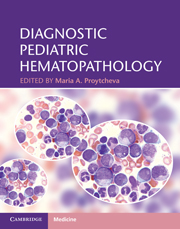Book contents
- Frontmatter
- Contents
- List of contributors
- Acknowledgements
- Introduction
- Section 1 General and non-neoplastic hematopathology
- Section 2 Neoplastic hematopathology
- 10 Chromosome abnormalities of hematologic malignancies
- 11 Expression profiling in pediatric acute leukemias
- 12 Myeloproliferative neoplasms
- 13 Myelodysplastic/myeloproliferative neoplasms
- 14 Myelodysplastic syndromes and therapy-related myeloid neoplasms
- 15 Acute myeloid leukemia and related precursor neoplasms
- 16 Hematologic abnormalities in individuals with Down syndrome
- 17 Precursor lymphoid neoplasms
- 18 Advances in prognostication and treatment of pediatric acute leukemia
- 19 The effect of chemotherapy, detection of minimal residual disease, and hematopoietic stem cell transplantation
- 20 Pediatric small blue cell tumors metastatic to the bone marrow
- 21 Pediatric mature B-cell non-Hodgkin lymphomas
- 22 Pediatric mature T-cell and NK-cell non-Hodgkin lymphomas
- 23 Hodgkin lymphoma
- 24 Immunodeficiency-associated lymphoproliferative disorders
- 25 Histiocytic proliferations in childhood
- 26 Cutaneous and subcutaneous lymphomas in children
- Index
- References
18 - Advances in prognostication and treatment of pediatric acute leukemia
from Section 2 - Neoplastic hematopathology
Published online by Cambridge University Press: 03 May 2011
- Frontmatter
- Contents
- List of contributors
- Acknowledgements
- Introduction
- Section 1 General and non-neoplastic hematopathology
- Section 2 Neoplastic hematopathology
- 10 Chromosome abnormalities of hematologic malignancies
- 11 Expression profiling in pediatric acute leukemias
- 12 Myeloproliferative neoplasms
- 13 Myelodysplastic/myeloproliferative neoplasms
- 14 Myelodysplastic syndromes and therapy-related myeloid neoplasms
- 15 Acute myeloid leukemia and related precursor neoplasms
- 16 Hematologic abnormalities in individuals with Down syndrome
- 17 Precursor lymphoid neoplasms
- 18 Advances in prognostication and treatment of pediatric acute leukemia
- 19 The effect of chemotherapy, detection of minimal residual disease, and hematopoietic stem cell transplantation
- 20 Pediatric small blue cell tumors metastatic to the bone marrow
- 21 Pediatric mature B-cell non-Hodgkin lymphomas
- 22 Pediatric mature T-cell and NK-cell non-Hodgkin lymphomas
- 23 Hodgkin lymphoma
- 24 Immunodeficiency-associated lymphoproliferative disorders
- 25 Histiocytic proliferations in childhood
- 26 Cutaneous and subcutaneous lymphomas in children
- Index
- References
Summary
Leukemia is the most common cause of cancer in childhood; it accounts for approximately 40% of all cases of cancer in patients less than 18 years of age. Acute lymphoblastic leukemia (ALL) is the more prevalent in this age group, and acute myeloid leukemia (AML) is less common [1, 2].
Over the last 40 years there has been tremendous success in the treatment of leukemias in children, particularly ALL. While, in the 1950s, a child diagnosed with ALL would have had a less than 5% chance of surviving, today the survival rate for ALL is much closer to 80%; with some subgroups it is as high as 90% [3–7]. Much praise needs to be given to the pediatric oncologists who came together to perform the clinical trials and also had the vision to understand the importance of the biologic aspects of leukemia to help develop improved therapies. From this approach we have learned that ALL and AML are both heterogeneous disorders, each one including various subtypes that have different clinical progression and response to therapy. Today, leukemia therapy in children is guided by a combination of factors including age, initial white cell count, underlying cytogenetics, and response to therapy. This chapter will focus on the advances in diagnosis, prognostication, and treatment of pediatric acute leukemia from a clinician's perspective.
- Type
- Chapter
- Information
- Diagnostic Pediatric Hematopathology , pp. 345 - 356Publisher: Cambridge University PressPrint publication year: 2011



